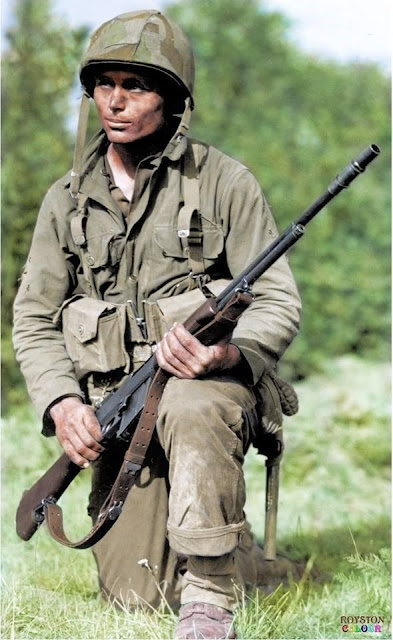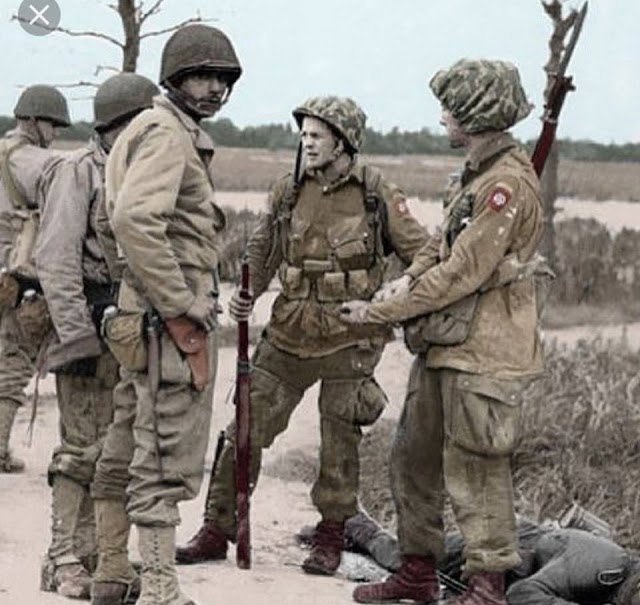 |
| January 1944, the 3rd Marine Raider Battalion gathers in front of a Japanese bunker they captured at Cape Torokina on Bougainville in the Solomon Islands. |
This is a collection of
color photographs of U.S. soldiers during World War II. The goal here was to assemble varied photographs from both the European and Pacific Theaters of Operation. Being in a military theater sometimes means combat, sometimes it means taking a break from fighting, sometimes it means fraternizing with civilians, and sometimes it means many other things. This page spans the varied experiences a soldier might experience while under the shadow of combat.
 |
| U.S. Marine aims his M1 Garand rifle atop Japanese ammunition crates on the Island of Iwo Jima, February/March 1945. |
For one reason or another, color photos of ordinary U.S. soldiers are relatively sparse. If you are looking for color images of World War II soldiers, you will find easy pickings of German or Soviet combatants. There are various reasons for this, but the main one is that there simply are more people involved in colorizing photos of those soldiers for whatever reasons.
 |
| A G.I. lights up on Iwo Jima, February 1945. |
A few notes about the photos. You will notice a lot of smoking - that was considered a luxury, and lighting up was not something that you could do regularly when in combat. A lot of the U.S. soldiers are using captured equipment, and that was quite common by both sides in all theaters of World War II.
 |
| PFC Floyd L. Rogers (18038434) from Texas and with 'C' Company, 38th Infantry Regiment, US 2nd Division in Northern France, June 29, 1944. (Note the German camo helmet cover) Rogers was KIA on July 12,1944. At the time of this photo, Rogers was credited with killing 27 enemy snipers with his (BAR) Browning Automatic Rifle. (Colorized by Royston Leonard). |
Of all the armed forces of World War II, the United States military had the most varied responsibilities. The G.I. was responsible for invading islands, defeating Rommel in the desert, and marching into Germany. While Britain and the Soviet Union held the German Wehrmacht off until December 1941, the U.S. infantryman came in as the closer, the final nail in Adolf Hitler's coffin. The quicker he succeeded, the sooner soldiers on both sides could go home and get on with their lives in peacetime.
 |
| Italy, May 29, 1944: U.S. sniper Pfc. Edward J. Foley, Co G, 143rd Infantry, 36th Infantry Division. He is holding a 5-shot Springfield 1903A4 bolt sniper rifle - with a 4-power scope. Note the helmet camouflage. |
Every photo on this page has been colorized, with only one or two possible exceptions. The rule followed here is that colorization is fine as long as it accurately attempts to reflect reality and is done tastefully.
 |
| Two U.S. Marine Corps snipers lined up on Okinawa, 1945. They have Springfield M1903A1 sniper rifles with 8x Unertl scopes. If you look closely, you will notice that the rifle on the right has just been fired because the scope has moved forward. The man on the left is about to fire, the scope is still in the back position. |
Incidentally, if you are curious about where the term "G.I." came from, you are not alone. There is no real definition for the term G.I. There are some who believe it means "Gun-carrying Infantry," and others who believe that it stems from "Government Issue," but nobody really knows. There is no record of the actual phrase from which the term G.I. derives. The only thing that is clear is that "G.I." refers to ordinary United States soldiers, usually members of the U.S. Army, the grunts who get muddy and dirty and win the wars.
 |
| US Marine Corps soldiers on Bougainville, 1943 (Life). |
If you like these color photos, you may wish to check out my other pages of color photos of World War II.
You may find more color photos of World War II on
page 1 and
page 2 and
page 3 and
page 4 and
page 5 and
page 6 and
page 7 and
page 8 and
page 9 and
page 10 and
page 11 and
page 12 and
page 13 and
page 14 and
page 15 and
page 16 of this series.
 |
| US Marines in landing craft, vehicle, personnel (LCVP) or Higgins boat. They are approaching Iwo Jima, 19 Feb 1945. The Marines are heading toward the right of Mount Suribachi, from which the Japanese could fire down on them with rifle fire and artillery. |
 |
| A few minutes after the previous photo, US Marines of the 28th Marine Regiment, 5th Marine Division after landing on Iwo Jima, 19th of February, 1945. |
 |
| The 1st Infantry Division of the United States Army (the Big Red One) preparing for the Normandy Invasion, 1944. |
 |
| Troops from the 96th Infantry Division gather around an M4 Sherman (US Army 3099276) of 'A' Company 763rd Tank Battalion on Okinawa, April 1945. |
 |
| Members of the US 78th Infantry Division take the surrender of two Germans during the fighting at Simmerath, Germany on 15 December 1944. |
 |
| US Staff Sergeant Francis Daggertt of the Military Police of the 11th Armored Division chats with a young German Wehrmacht soldier. The German is only 10 years old when captured in the German city of Kronach, April 27, 1945. |
 |
| Soldiers from the U.S. 4th Armored Division in a Ford GPW jeep pass by a camouflaged M5 Stuart light-tank belonging to the 37th Armored Regiment during the surrender in Hersfeld, Germany, 31st of March, 1945. The soldiers in the jeep are transporting two captured German officers, perhaps for interrogation. |
 |
| US soldiers of the 2nd Battalion, 314th Infantry Regiment-79th Infantry Division receive wine during the fighting around Drusenheim. |
 |
| A paratrooper from the 17th US Airborne Division gets a light from a Churchill tank crewman of 6th Guards Tank Brigade near Dorsten in North Rhine-Westphalia, Germany, 29th March 1945. One of the G.I.s is wearing a Wehrmacht belt as a souvenir. |
 |
| US soldiers of the 82nd Airborne rest after a firefight. Note the dead German soldier. |
 |
| Riflemen of the 317th Infantry Regiment, US 80th Infantry Division take a moment to roll their own cigarettes while in Goesdorf, Luxembourg on January 10, 1945. On the left is SSG Abraham Aranoff, a native of Boston, Mass., to the right is, Private Henry W. Beyer of Grand Rapids, Michigan. (Photograph by M.H.Miller 167th US Signal Company) (Colorized by Johnny Sirlande from Belgium). |
 |
| An American Medic and a GI of the US. 80th Infantry Division read the comics. |
 |
| A medic of the 4th infantry division taking care of another medic after the successful invasion of Utah beach. The photograph was taken on 6 June 1944 during Operation Overlord. |
 |
| A US soldier with a captured STG44, Salzburgen, France, 1945. |
2018





















Interesting as always, thanks. As a native speaker of German, I noticed the sign "Kreisleitung SVG Salzburgen" in the last picture. Salzburgen, however, is NOT the Austrian town of Salzburg north of Berchtesgaden, Salzburgen is a small town in Northern France, see
ReplyDeletehttps://en.wikipedia.org/wiki/Château-Salins
The name obviously has the same origin (derived from "salt" and "castle"), but the photo has been taken in France and not in Germany/Austria. The German version of the Wikipedia article about Salzburgen states that the name "Château-Salins" was translated into "Salzburgen" after the German occupation to avoid confusion with the much more known city of Salzburg.
Great stuff here!!!
ReplyDelete